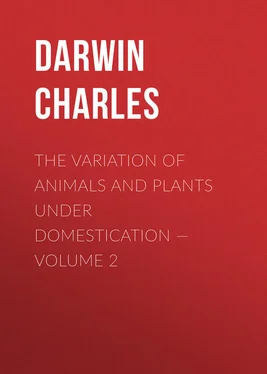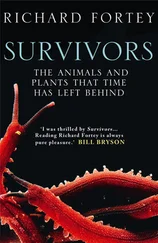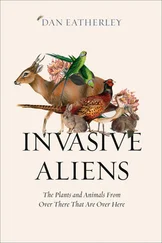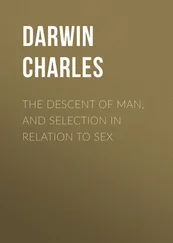Charles Darwin - The Variation of Animals and Plants under Domestication — Volume 2
Здесь есть возможность читать онлайн «Charles Darwin - The Variation of Animals and Plants under Domestication — Volume 2» — ознакомительный отрывок электронной книги совершенно бесплатно, а после прочтения отрывка купить полную версию. В некоторых случаях можно слушать аудио, скачать через торрент в формате fb2 и присутствует краткое содержание. Жанр: foreign_antique, foreign_prose, на английском языке. Описание произведения, (предисловие) а так же отзывы посетителей доступны на портале библиотеки ЛибКат.
- Название:The Variation of Animals and Plants under Domestication — Volume 2
- Автор:
- Жанр:
- Год:неизвестен
- ISBN:нет данных
- Рейтинг книги:3 / 5. Голосов: 1
-
Избранное:Добавить в избранное
- Отзывы:
-
Ваша оценка:
- 60
- 1
- 2
- 3
- 4
- 5
The Variation of Animals and Plants under Domestication — Volume 2: краткое содержание, описание и аннотация
Предлагаем к чтению аннотацию, описание, краткое содержание или предисловие (зависит от того, что написал сам автор книги «The Variation of Animals and Plants under Domestication — Volume 2»). Если вы не нашли необходимую информацию о книге — напишите в комментариях, мы постараемся отыскать её.
The Variation of Animals and Plants under Domestication — Volume 2 — читать онлайн ознакомительный отрывок
Ниже представлен текст книги, разбитый по страницам. Система сохранения места последней прочитанной страницы, позволяет с удобством читать онлайн бесплатно книгу «The Variation of Animals and Plants under Domestication — Volume 2», без необходимости каждый раз заново искать на чём Вы остановились. Поставьте закладку, и сможете в любой момент перейти на страницу, на которой закончили чтение.
Интервал:
Закладка:
On the other hand, some cultivated plants rarely or never intercross, for instance, the common pea and sweet-pea (Lathyrus odoratus); yet their flowers are certainly adapted for cross fertilisation. The varieties of the tomato and aubergine (Solanum) and the pimenta (Pimenta vulgaris?) are said (15/16. Verlot 'Des Varietes' 1865 page 72.) never to cross, even when growing alongside one another. But it should be observed that these are all exotic plants, and we do not know how they would behave in their native country when visited by the proper insects. With respect to the common pea, I have ascertained that it is rarely crossed in this country owing to premature fertilisation. There exist, however, some plants which under their natural conditions appear to be always self-fertilised, such as the Bee Ophrys (Ophrys apifera) and a few other Orchids; yet these plants exhibit the plainest adaptations for cross-fertilisation. Again, some few plants are believed to produce only closed flowers, called cleistogene, which cannot possibly be crossed. This was long thought to be the case with the Leersia oryzoides (15/17. Duval Jouve 'Bull. Soc. Bot. de France' tome 10 1863 page 194. With respect to the perfect flowers setting seed see Dr. Ascherson in 'Bot. Zeitung' 1864 page 350.), but this grass is now known occasionally to produce perfect flowers, which set seed.
Although some plants, both indigenous and naturalised, rarely or never produce flowers, or if they flower never produce seeds, yet no one doubts that phanerogamic plants are adapted to produce flowers, and the flowers to produce seed. When they fail, we believe that such plants under different conditions would perform their proper function, or that they formerly did so, and will do so again. On analogous grounds, I believe that the flowers in the above specified anomalous cases which do not now intercross, either would do so occasionally under different conditions, or that they formerly did so — the means for affecting this being generally still retained — and will again intercross at some future period, unless indeed they become extinct. On this view alone, many points in the structure and action of the reproductive organs in hermaphrodite plants and animals are intelligible, — for instance, the fact of the male and female organs never being so completely enclosed as to render access from without impossible. Hence we may conclude that the most important of all the means for giving uniformity to the individuals of the same species, namely, the capacity of occasionally intercrossing, is present, or has been formerly present, with all organic beings, except, perhaps, some of the lowest.
[ON CERTAIN CHARACTERS NOT BLENDING.
When two breeds are crossed their characters usually become intimately fused together; but some characters refuse to blend, and are transmitted in an unmodified state either from both parents or from one. When grey and white mice are paired, the young are piebald, or pure white or grey, but not of an intermediate tint; so it is when white and common collared turtle-doves are paired. In breeding Game fowls, a great authority, Mr. J. Douglas, remarks, "I may here state a strange fact: if you cross a black with a white game, you get birds of both breeds of the clearest colour." Sir R. Heron crossed during many years white, black, brown, and fawn-coloured Angora rabbits, and never once got these colours mingled in the same animal, but often all four colours in the same litter. (15/18. Extract of a letter from Sir R. Heron 1838 given me by Mr. Yarrell. With respect to mice see 'Annal. des Sc. Nat.' tome 1 page 180; and I have heard of other similar cases. For turtle-doves Boitard and Corbie 'Les Pigeons' etc. page 238. For the Game fowl 'The Poultry Book' 1866 page 128. For crosses of tailless fowls see Bechstein 'Naturges. Deutsch.' b. 3 s. 403. Bronn 'Geschichte der Natur' b. 2 s. 170 gives analogous facts with horses. On the hairless condition of crossed South American dogs see Rengger 'Saugethiere von Paraguay' s. 152; but I saw in the Zoological Gardens mongrels, from a similar cross, which were hairless, quite hairy, or hairy in patches, that is, piebald with hair. For crosses of Dorking and other fowls see 'Poultry Chronicle' volume 2 page 355. About the crossed pigs, extract of letter from Sir R. Heron to Mr. Yarrell. For other cases see P. Lucas 'L'Hered. Nat.' tome 1 page 212.) From cases like these, in which the colours of the two parents are transmitted quite separately to the offspring, we have all sorts of gradations, leading to complete fusion. I will give an instance: a gentleman with a fair complexion, light hair but dark eyes, married a lady with dark hair and complexion: their three children have very light hair, but on careful search about a dozen black hairs were found scattered in the midst of the light hair on the heads of all three.
When turnspit dogs and ancon sheep, both of which have dwarfed limbs, are crossed with common breeds, the offspring are not intermediate in structure, but take after either parent. When tailless or hornless animals are crossed with perfect animals, it frequently, but by no means invariably, happens that the offspring are either furnished with these organs in a perfect state, or are quite destitute of them. According to Rengger, the hairless condition of the Paraguay dog is either perfectly or not at all transmitted to its mongrel offspring; but I have seen one partial exception in a dog of this parentage which had part of its skin hairy, and part naked, the parts being distinctly separated as in a piebald animal. When Dorking fowls with five toes are crossed with other breeds, the chickens often have five toes on one foot and four on the other. Some crossed pigs raised by Sir R. Heron between the solid- hoofed and common pig had not all four feet in an intermediate condition, but two feet were furnished with properly divided, and two with united hoofs.
Analogous facts have been observed with plants: Major Trevor Clarke crossed the little, glabrous-leaved, annual stock (Matthiola), with pollen of a large, red-flowered, rough-leaved, biennial stock, called cocardeau by the French, and the result was that half the seedlings had glabrous and the other half rough leaves, but none had leaves in an intermediate state. That the glabrous seedlings were the product of the rough-leaved variety, and not accidentally of the mother-plant's own pollen, was shown by their tall and strong habit of growth. (15/19. 'Internat. Hort. and Bot. Congress of London' 1866.) in the succeeding generations raised from the rough-leaved crossed seedlings, some glabrous plants appeared, showing that the glabrous character, though incapable of blending with and modifying the rough leaves, was all the time latent in this family of plants. The numerous plants formerly referred to, which I raised from reciprocal crosses between the peloric and common Antirrhinum, offer a nearly parallel case; for in the first generation all the plants resembled the common form, and in the next generation, out of one hundred and thirty-seven plants, two alone were in an intermediate condition, the others perfectly resembling either the peloric or common form. Major Trevor Clarke also fertilised the above-mentioned red-flowered stock with pollen from the purple Queen stock, and about half the seedlings scarcely differed in habit, and not at all in the red colour of the flower, from the mother-plant, the other half bearing blossoms of a rich purple, closely like those of the paternal plant. Gartner crossed many white and yellow-flowered species and varieties of Verbascum; and these colours were never blended, but the offspring bore either pure white or pure yellow blossoms; the former in the larger proportion. (15/20. 'Bastarderzeugung' s. 307. Kolreuter 'Dritte Fortsetszung' s. 34, 39 however, obtained intermediate tints from similar crosses in the genus Verbascum. With respect to the turnips see Herbert 'Amaryllidaceae' 1837 page 370.) Dr. Herbert raised many seedlings, as he informed me, from Swedish turnips crossed by two other varieties, and these never produced flowers of an intermediate tint, but always like one of their parents. I fertilised the purple sweet-pea (Lathyrus odoratus), which has a dark reddish-purple standard-petal and violet-coloured wings and keel, with pollen of the painted lady sweet-pea, which has a pale cherry-coloured standard, and almost white wings and keel; and from the same pod I twice raised plants perfectly resembling both sorts; the greater number resembling the father. So perfect was the resemblance, that I should have thought there had been some mistake, if the plants which were at first identical with the paternal variety, namely, the painted-lady, had not later in the season produced, as mentioned in a former chapter, flowers blotched and streaked with dark purple. I raised grandchildren and great-grandchildren from these crossed plants, and they continued to resemble the painted-lady, but during later generations became rather more blotched with purple, yet none reverted completely to the original mother-plant, the purple sweet-pea. The following case is slightly different, but still shows the same principle: Naudin (15/21. 'Nouvelles Archives du Museum' tome 1 page 100.) raised numerous hybrids between the yellow Linaria vulgaris and the purple L. purpurea, and during three successive generations the colours kept distinct in different parts of the same flower.
Читать дальшеИнтервал:
Закладка:
Похожие книги на «The Variation of Animals and Plants under Domestication — Volume 2»
Представляем Вашему вниманию похожие книги на «The Variation of Animals and Plants under Domestication — Volume 2» списком для выбора. Мы отобрали схожую по названию и смыслу литературу в надежде предоставить читателям больше вариантов отыскать новые, интересные, ещё непрочитанные произведения.
Обсуждение, отзывы о книге «The Variation of Animals and Plants under Domestication — Volume 2» и просто собственные мнения читателей. Оставьте ваши комментарии, напишите, что Вы думаете о произведении, его смысле или главных героях. Укажите что конкретно понравилось, а что нет, и почему Вы так считаете.












